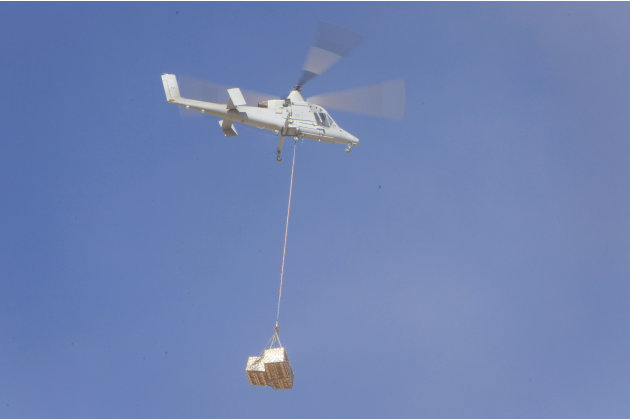M WAQAR..... "A man's ethical behavior should be based effectually on sympathy, education, and social ties; no religious basis is necessary.Man would indeed be in a poor way if he had to be restrained by fear of punishment and hope of reward after death." --Albert Einstein !!! NEWS,ARTICLES,EDITORIALS,MUSIC... Ze chi pe mayeen yum da agha pukhtunistan de.....(Liberal,Progressive,Secular World.)''Secularism is not against religion; it is the message of humanity.'' تل ده وی پثتونستآن
Saturday, January 7, 2012
Cargo drone makes debut in Afghanistan
The U.S. military is testing a revolutionary new drone for its arsenal,
a pilotless helicopter intended to fly cargo missions to remote outposts where frequent roadside bombs threaten access by road convoys.
Surveillance drones for monitoring enemy activity and armed versions for launching airstrikes have become a trademark of America's wars in Afghanistan, Iraq and elsewhere in the Middle East. But this is the first time a chopper version designed for transport has ben used operationally.
Two unmanned models of the Kaman K-MAX helicopters and a team of 16 company technicians and 8 Marines are conducting a 6-month evaluation program for the new craft at Camp Dwyer, a Marine Corps airfield in the Garmsir district of southern Helmand Province.
The craft have flown 20 transport missions since the inaugural flight on Dec. 17, said Maj. Kyle O'Connor, the officer in charge of the detachment. They have delivered nearly 18 tons of cargo, mainly thousands of Meals Ready to Eat and spare parts needed at the forward operating bases.
"Afghanistan is a highly mined country and the possibility of improvised explosive devices is always a problem moving cargo overland in a convoy," O'Connor said.
"Every load that we can take off of a ground convoy reduces the danger and risk that our Marines, soldiers, and sailors are faced with," he said. "With an unmanned helicopter, even the aircrew is taken out of harm's way."
The Marines from Unmanned Aerial Vehicle Squadron 1 lead the missions and deliver the cargo into combat drop zones, while contractors operate and maintain the two aircraft.
The craft's onboard computer uploads the mission plans, enabling them to fly on autopilot. But an operator at base control monitors progress and can step in and override the autopilot for manual operation if any problems occur, or if the drone must be redirected in mid-flight.
The K-MAX is the latest in a series of Kaman synchronized twin-rotor helicopters dating from the 1950s. The unusual arrangement, with two side-by-side pylons on the helicopter's roof supporting counter-rotating blades, results in exceptional stability while hovering and allows pinpoint cargo delivery.
During the Vietnam War, a previous Kaman model, the two-pilot HH-43 Huskie, flew more rescue missions than all other aircraft combined because of this unique hovering capability.
The manned version of the K-MAX helicopter first appeared in the 1990s, and the pilotless prototype was unveiled in 2008. It can carry a maximum payload of 6,855 pounds (3,100 kilograms) and costs about $1,100 an hour to operate, several times less than any manned helicopter.
After a six-month test period, the military will determine whether to put the craft into regular operational use.
Throughout the 10-year war, NATO troops have wrestled with serious logistics problems in the high-threat areas of southern and eastern Afghanistan. Resupplying the isolated forward operating bases has meant facing the dangers of frequent ambushes and roadside bombs.
This has meant that specialized escort units, known as route clearance packages, must escort all supply convoys.
"This is very time-consuming because you have to clear the routes for every single mission," said Theo Farrell, Professor of War at King's College London. "Also, there is a shortage of route clearance packages due to the high demand for them."
But the use of large manned helicopters to deliver supplies has also proved problematic as they present easy targets for Taliban machine-gunners while hovering over the delivery point, he said.
"The use of drone choppers could resolve both problems," Farrell said. "It reduces the need for armed escorts and presents a much smaller target to the enemy."
Subscribe to:
Post Comments (Atom)

No comments:
Post a Comment